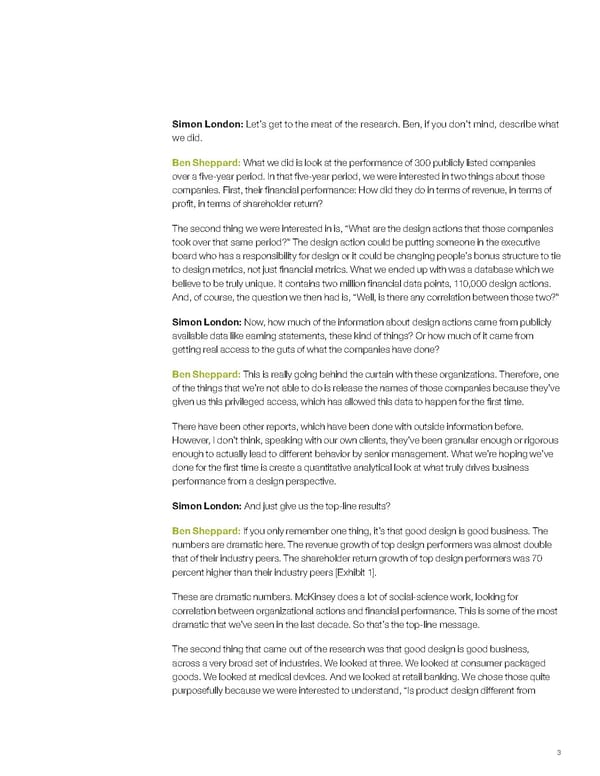Simon London: Let’s get to the meat of the research. Ben, if you don’t mind, describe what we did. Ben Sheppard: What we did is look at the performance of 300 publicly listed companies over a five-year period. In that five-year period, we were interested in two things about those companies. First, their financial performance: How did they do in terms of revenue, in terms of profit, in terms of shareholder return? The second thing we were interested in is, “What are the design actions that those companies took over that same period?” The design action could be putting someone in the executive board who has a responsibility for design or it could be changing people’s bonus structure to tie to design metrics, not just financial metrics. What we ended up with was a database which we believe to be truly unique. It contains two million financial data points, 110,000 design actions. And, of course, the question we then had is, “Well, is there any correlation between those two?” Simon London: Now, how much of the information about design actions came from publicly available data like earning statements, these kind of things? Or how much of it came from getting real access to the guts of what the companies have done? Ben Sheppard: This is really going behind the curtain with these organizations. Therefore, one of the things that we’re not able to do is release the names of those companies because they’ve given us this privileged access, which has allowed this data to happen for the first time. There have been other reports, which have been done with outside information before. However, I don’t think, speaking with our own clients, they’ve been granular enough or rigorous enough to actually lead to different behavior by senior management. What we’re hoping we’ve done for the first time is create a quantitative analytical look at what truly drives business performance from a design perspective. Simon London: And just give us the top-line results? Ben Sheppard: If you only remember one thing, it’s that good design is good business. The numbers are dramatic here. The revenue growth of top design performers was almost double that of their industry peers. The shareholder return growth of top design performers was 70 percent higher than their industry peers [Exhibit 1]. These are dramatic numbers. McKinsey does a lot of social-science work, looking for correlation between organizational actions and financial performance. This is some of the most dramatic that we’ve seen in the last decade. So that’s the top-line message. The second thing that came out of the research was that good design is good business, across a very broad set of industries. We looked at three. We looked at consumer packaged goods. We looked at medical devices. And we looked at retail banking. We chose those quite purposefully because we were interested to understand, “Is product design different from 3
 Tapping into the business value of design Page 2 Page 4
Tapping into the business value of design Page 2 Page 4